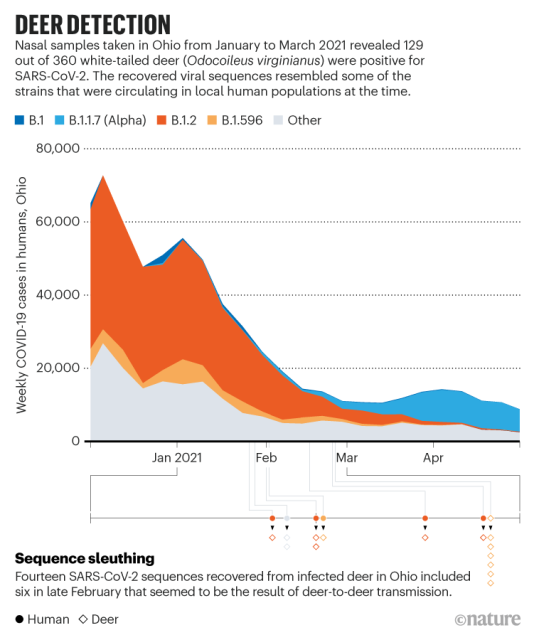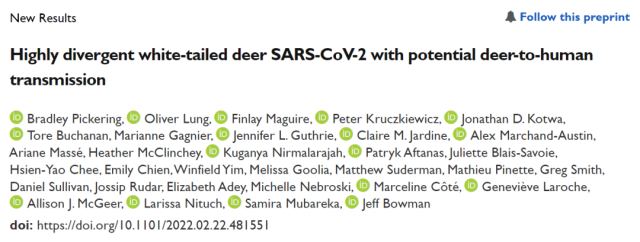New coronavirus continuing to spread in herds of white-tailed deer
- Normal Liver Cells Found to Promote Cancer Metastasis to the Liver
- Nearly 80% Complete Remission: Breakthrough in ADC Anti-Tumor Treatment
- Vaccination Against Common Diseases May Prevent Dementia!
- New Alzheimer’s Disease (AD) Diagnosis and Staging Criteria
- Breakthrough in Alzheimer’s Disease: New Nasal Spray Halts Cognitive Decline by Targeting Toxic Protein
- Can the Tap Water at the Paris Olympics be Drunk Directly?
New coronavirus continuing to spread in herds of white-tailed deer
- Should China be held legally responsible for the US’s $18 trillion COVID losses?
- CT Radiation Exposure Linked to Blood Cancer in Children and Adolescents
- FDA has mandated a top-level black box warning for all marketed CAR-T therapies
- Can people with high blood pressure eat peanuts?
- What is the difference between dopamine and dobutamine?
- How long can the patient live after heart stent surgery?
New coronavirus continuing to spread in herds of white-tailed deer
Nature concern: The new coronavirus is spreading in wild animals, what does this mean for the COVID-19 pandemic?
In North America, there are a large number of wild white-tailed deer. There are about 30 million in the United States and millions in Canada. The total number exceeds one tenth of the total population of North America.
With the pandemic of the new coronavirus, a considerable number of humans in the United States and Canada have been infected with the new coronavirus. At the end of 2021, a paper published in Nature showed that many wild white-tailed deer in North America have been infected with the new coronavirus, and even more A new coronavirus variant. This suggests that the new coronavirus may survive long-term in wild white-tailed deer, bringing a new way for the new coronavirus to further evolve and re-transmit humans.
There is no evidence yet that the new coronavirus in wild animals can be transmitted to humans, but scientists are increasingly concerned that these white-tailed deer could act as reservoirs for the new coronavirus, creating new mutant strains and bringing new outbreaks. Other studies suggest that Omicron lurked in animal hosts for a period of time before a large outbreak in humans.
So far, these white-tailed deer infected with the new coronavirus have not shown any symptoms, but they may spread the new coronavirus to other livestock or wildlife, and once the new coronavirus spreads widely among wild animals, the outbreak will become difficult to control.
Since the beginning of the COVID-19 pandemic, researchers have focused on wildlife infections. For targeted monitoring, the researchers first studied ACE2 , the receptor protein for the new coronavirus to invade human cells. Animals with ACE2 protein similar to humans are at risk of contracting the new coronavirus. Research teams around the world have begun experimental infection testing of these animals to determine whether they can infect and transmit the new coronavirus.
Studies have shown that primates, cats, deer mice, raccoon dogs, minks, white-tailed deer and other animals have the potential to infect and transmit the new coronavirus.
In January 2021, USDA researchers found that captive white-tailed deer were able to contract the new coronavirus and spread it to other white-tailed deer in adjacent enclosures through nasal mucus and feces .
The deer developed antibodies against the new coronavirus within a week of being infected with the new coronavirus, and they showed no obvious symptoms. These findings are surprising because other ungulates, such as cattle and sheep, are not infected with the new coronavirus.
And in July 2021, researchers from the US National Wildlife Research Center published a paper in the preprint bioRxiv . They tested 385 blood samples collected from white-tailed deer between January 2021 and March 2021 and found that antibodies against the new coronavirus could be detected in nearly 40% of the blood samples, indicating that there are already a considerable proportion of white-tailed deer. Deer have been infected with the new coronavirus, and this is the first time that wild animals have been widely exposed to the new coronavirus.
In fact, scientists had already started testing white-tailed deer in 2020, when the COVID-19 pandemic began, but testing throughout 2020 did not find them infected with the COVID-19 virus.
In 2021, the situation has completely changed. Various testing samples starting in January 2021 have found a large number of new coronavirus infections in the wild white-tailed deer population. And this comes right after the peak of infections in humans, especially in the United States.
The new coronavirus variant detected in the white-tailed deer herd also proves that humans have repeatedly transmitted the latest new coronavirus variant to the wild white-tailed deer herd.

Since January 2021, researchers have detected wild white-tailed deer infected with the new coronavirus in 24 U.S. states, as well as across Canada.
At the end of December 2021, wild white-tailed deer on Staten Island in New York City were also tested for Omicron variants. In March 2022, the new coronavirus was detected in wild mule deer in Utah.
However, the spread of Covid-19 in wild deer herds appears to be limited to North America, and so far no Covid-19 infections have been detected in wild deer herds in Europe. Biological differences cannot explain this phenomenon, and from the perspective of ACE2 receptors, the susceptibility to COVID-19s of European deer herds and North American white-tailed deer is similar.
This suggests that the spread of the new coronavirus in white-tailed deer in North America is likely due to the high population density of white-tailed deer there and frequent contact with humans.
In North America, wild deer often roam around in the wild and even walk into people’s backyards, but this is rare elsewhere, where wild animals usually live in protected areas.
So far, it remains unclear how these wild white-tailed deer contracted the new coronavirus. It may be due to direct contact, such as when a human is directly petting or feeding a white-tailed deer.
In some states in the United States, some people specialize in raising white-tailed deer, and there are some treatments for injured white-tailed deer, which may lead to close contact with humans.
When they are infected with the new coronavirus and then return to the wild, they may spread the new coronavirus. to other white-tailed deer. But these contacts hardly explain such a large percentage of transmission in such a wild deer herd.
Therefore, there is also the view that these wild white-tailed deer may have contracted the new coronavirus through environmental contact, but this has not been strictly confirmed.

In the U.S., white-tailed deer have adapted well to living around humans
There is also a view that wastewater contaminated with the new coronavirus flowing into wild water sources may infect white-tailed deer with the COVID-19. Many studies have found SARS-CoV-2 RNA in sewage, but no infectious SARS-CoV-2 strain has been isolated from wastewater.
In addition, there are also reports that animals such as wild cats or wild mink may be used as vectors to cause white-tailed deer to contract the new coronavirus.
The above views seem to have some truth, but they cannot fully explain the large-scale transmission in wild white-tailed deer. It is likely that they are not caused by a single cause of infection and transmission, but caused by a combination of reasons .
White-tailed deer are gregarious animals and they usually live within a range of a few square kilometers, however, this changes during the breeding season from October to February each year. During this time, the deer herds come into contact with each other and greatly expand their range.
There will be a lot of nose-to-nose contact between them, which leads to the fact that once a deer is infected with the new coronavirus, their behavior can easily cause the new coronavirus to spread widely within the population.
The Middle East Respiratory Syndrome (MERS-CoV) , which previously broke out in the Middle East , is also a deadly infectious disease caused by a coronavirus. The virus was transmitted to humans by camels. Therefore, scientists are concerned that white-tailed deer become a host for the new coronavirus, thereby spreading to humans.
Once the new coronavirus establishes a long-term infection in white-tailed deer, it may mutate, evolve, and recombine with other coronaviruses in its body, thereby potentially infecting other deer or grazing animals such as sheep, goats, cows, etc.
And more and more studies have proved this, and the new coronavirus shows signs of long-term evolution in white-tailed deer. In February of this year, researchers from the Canadian Food Inspection Agency published a study in the preprint bioRxiv that showed that the new coronavirus infected with white-tailed deer sampled in Ontario had 76 mutation sites compared with the original strain of the new coronavirus.
These mutations Changes in the S protein that cause SARS-CoV-2 to invade host cells are key to the success of the highly transmissible variant. Analysis of the genomes of these viruses revealed that the closest relative was the new coronavirus that infected humans a year ago, suggesting that the virus has been circulating in white-tailed deer for a long time.

In February, a paper published by the University of Pennsylvania in the preprint medRxiv showed that a COVID-19 alpha variant strain different from the human genome was found in the local white-tailed deer, suggesting that the alpha variant has been independently evolving in the white-tailed deer after previously infecting the white-tailed deer.

What’s more, studies have found that the genome of the new coronavirus in a human in Ontario is highly similar to the new coronavirus found in white-tailed deer, and despite the lack of key evidence, scientists suspect that this person may have contracted the new coronavirus from the white-tailed deer.
If this is confirmed, the spread of white-tailed deer to humans would be a concern.
In addition, white-tailed deer, like humans, can be infected with the new coronavirus multiple times.
For example, studies have found that white-tailed deer infected with Omicron also have antibodies against Delta, which shows that white-tailed deer can be infected with the new coronavirus multiple times, which also means that It will be difficult for the new coronavirus to disappear from the white-tailed deer, thereby continuing to spread.
Original link :
https://www.nature.com/articles/d41586-022-01112-4
New coronavirus continuing to spread in herds of white-tailed deer
(source:internet, reference only)
Disclaimer of medicaltrend.org
Important Note: The information provided is for informational purposes only and should not be considered as medical advice.



